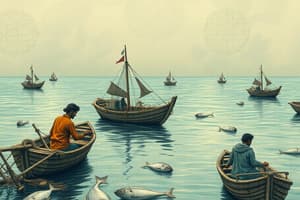Podcast
Questions and Answers
What is the main goal of Coastal Resource Management (CRM)?
What is the main goal of Coastal Resource Management (CRM)?
- To focus solely on the ecological health of coastal areas.
- To exploit coastal resources for maximum economic gain.
- To sustainably manage coastal areas by balancing ecological health, community well-being, and economic activity. (correct)
- To disregard community needs in favor of economic development in coastal regions.
Conservation in the context of natural resources refers to their unlimited use without regard to future availability.
Conservation in the context of natural resources refers to their unlimited use without regard to future availability.
False (B)
Name three major activities that involve communities in the CRM process?
Name three major activities that involve communities in the CRM process?
Identification of stakeholders and formation of partnerships, Community organization and mobilization, Community participation in the planning process
__________ is the careful maintenance and upkeep of a natural resource to prevent it from disappearing.
__________ is the careful maintenance and upkeep of a natural resource to prevent it from disappearing.
Which of the following is NOT a CRM tool or technology for conservation?
Which of the following is NOT a CRM tool or technology for conservation?
Which of the following best describes the benefit of using CRM tools and technologies in coastal management?
Which of the following best describes the benefit of using CRM tools and technologies in coastal management?
A key challenge in coastal resource management is decreasing community engagement and participation.
A key challenge in coastal resource management is decreasing community engagement and participation.
Name two potential opportunities for CRM to enhance conservation efforts.
Name two potential opportunities for CRM to enhance conservation efforts.
A potential opportunity for CRM to enhance conservation efforts includes increasing public __________.
A potential opportunity for CRM to enhance conservation efforts includes increasing public __________.
Match the following activities with their role in the CRM process:
Match the following activities with their role in the CRM process:
Which factor is LEAST important when trying to sustainably manage coastal areas?
Which factor is LEAST important when trying to sustainably manage coastal areas?
Coastal Inundation Mapping is a CRM tool used for environmental assessment.
Coastal Inundation Mapping is a CRM tool used for environmental assessment.
What is the role of Geographic Information Systems (GIS) in CRM?
What is the role of Geographic Information Systems (GIS) in CRM?
In CRM an Environmental ___________ Index Map identifies resources that are at risk.
In CRM an Environmental ___________ Index Map identifies resources that are at risk.
Which of the following is a key benefit of enhanced decision-making in CRM?
Which of the following is a key benefit of enhanced decision-making in CRM?
Improved fisheries management is considered a challenge for CRM.
Improved fisheries management is considered a challenge for CRM.
What is the purpose of stakeholder identification in the CRM process?
What is the purpose of stakeholder identification in the CRM process?
CRM aims for balancing ecological health, community well-being, and ________ activity.
CRM aims for balancing ecological health, community well-being, and ________ activity.
Match the tool with the provided benefits.
Match the tool with the provided benefits.
Which organizations were cited as an example of conservation organizations successfully using CRM systems?
Which organizations were cited as an example of conservation organizations successfully using CRM systems?
Flashcards
Coastal Resource Management (CRM)
Coastal Resource Management (CRM)
A strategy for sustainably managing coastal areas, focusing on balancing ecological health, community well-being, and economic activity by managing valuable resources.
Conservation
Conservation
Careful maintenance and upkeep of a natural resource to prevent its disappearance.
Activities of CRM
Activities of CRM
Identification of stakeholders, community organization/mobilization, community participation, and information, education, and communication
CRM Tools
CRM Tools
Signup and view all the flashcards
Benefits of Tools
Benefits of Tools
Signup and view all the flashcards
CRM System Examples
CRM System Examples
Signup and view all the flashcards
Study Notes
- Coastal Resource Management (CRM) is a strategy for sustainably managing coastal areas.
- CRM balances ecological health, community well-being, and economic activity.
- CRM includes activities to manage and sustain economically and ecologically valuable resources in coastal areas.
Conservation
- Conservation is the careful maintenance and upkeep of a natural resource to prevent it from disappearing.
Community Involvement in CRM
- Major activities involve communities in the CRM process.
- Identification of stakeholders is a key activity.
- Formation of partnerships with stakeholders is crucial.
- Community organization and mobilization are important for CRM.
- Community participation in the planning process is necessary.
- Information, education, and communication (IEC) are vital in CRM.
CRM Tools and Technologies for Conservation
- Geographic Information Systems (GIS) are used in CRM.
- Coastal Inundation Mapping is a CRM tool.
- Environmental Sensitivity Index Maps are utilized.
Benefits of CRM Tools
- CRM tools enhance decision-making.
- They improve resource management.
- They increase community resilience to coastal hazards.
- CRM tools enable better understanding of coastal ecosystems.
- They help inform sustainable practices.
Challenges in CRM
- Improved fisheries management is a challenge.
- Enhanced protection of coastal habitats and ecosystems faces challenges.
- Increasing community engagement and participation is difficult.
- Better management of coastal hazards and risks needs improvement.
Opportunities in CRM
- There are potential opportunities for CRM to enhance conservation efforts.
- Increasing public awareness is an opportunity.
- Boosting engagement is an opportunity.
- Improving operational efficiency is an opportunity.
Case Studies/Examples
- Conservation organizations like the WWF or Greenpeace successfully use CRM systems.
- Managing relationships with donors and volunteers is important for conservation efforts.
Studying That Suits You
Use AI to generate personalized quizzes and flashcards to suit your learning preferences.




